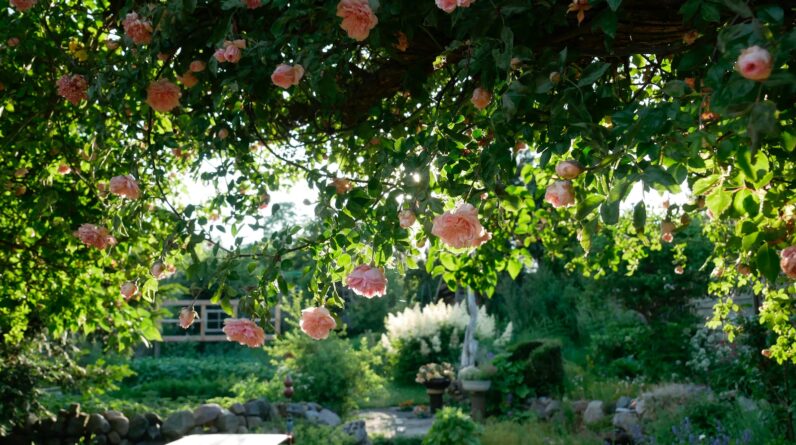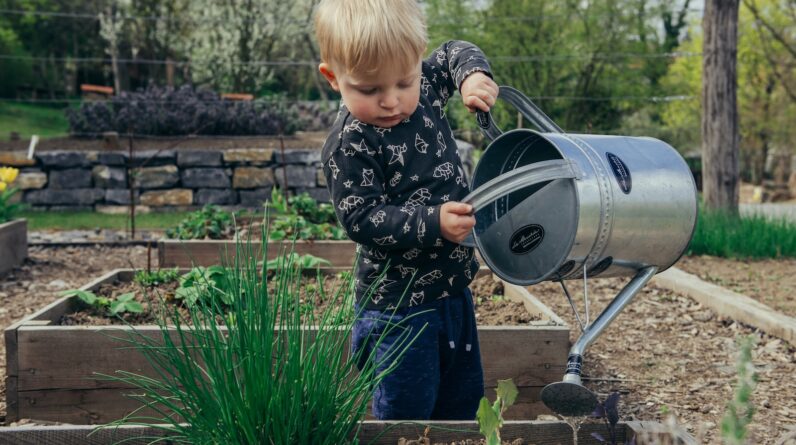
You’re about to dive into the art of landscape gardening, and it’s not just about planting. Imagine a line guiding your garden’s design, a focal point catching the eye, and clusters of plants adding depth.
Consider the unity, space, proportions, textures, time, light, color, and movement in your garden. Your personal touch breathes life into this space.
Let’s explore these ten principles together, helping you transform your backyard into your dream garden.
Key Takeaways
- Axis: The use of an axis creates a sense of order and structure in a garden, with a focal point at the end to draw attention.
- Unity: Creating unity between the house and the garden through features like training creepers and foundation planting helps to harmonize the overall design.
- Space: Maximizing open spaces and avoiding obstructing views with large plantings or shrubs helps to create a sense of spaciousness in the garden.
- Proportion and scale: Paying attention to proportion and scale, such as using a pleasing ratio for garden shapes and considering the size of features in relation to the overall space, is important for achieving a balanced and visually pleasing garden design.
Understanding the Garden Axis
In your landscape garden, the axis refers to an imaginary line that forms the basis for your garden’s layout. As a landscape gardener, you use this axis to provide structure and guide the placement of elements within the garden. It’s a fundamental part of landscape gardening, and understanding it can make the difference in how you make a beautiful landscape garden.
The axis can be straight or curved, depending on your design’s aesthetic. It often extends from a focal point, like a stunning tree or a statue, creating a visual path that leads the eye through your garden. This intentional design strategy adds depth and interest to your garden, making it not just a collection of plants, but a cohesive, captivating space.
Identifying the Focal Point
After establishing your garden’s axis, your next step is to identify a focal point that will catch the viewer’s eye. This can be an architectural feature, a statue, a water feature, or even a standout plant. Your focal point should create visual interest and draw attention, acting as the centerpiece of your garden.
It’s crucial to position your focal point to optimize its visibility along the garden’s axis. Consider scale and proportion when selecting your focal point. It should be harmonious with the garden’s size and style, yet distinct enough to command attention. Landscape lighting can further enhance your focal point, highlighting its features even at night.
Now that you’ve identified your focal point, let’s move on to creating the mass effect.
Creating the Mass Effect
Having identified your garden’s focal point, you’re now ready to create the mass effect, a key principle that can significantly enhance your garden’s aesthetic appeal. This method involves planting large groups of the same plant species together to create a visual impact.
Here’s how you can effectively implement the mass effect:
- Choose plants that thrive in your garden’s conditions. This will ensure they grow healthily and provide a lush, full appearance.
- Consider plants that have striking colors or unique forms. This can enhance the overall effect.
- Think about seasonality. Select plants that will provide interest throughout the year.
Achieving Unity in the Garden
To achieve a sense of unity in your garden, it’s crucial to ensure that all the elements harmonize well with each other. Start by pairing plants with similar needs for easy maintenance. Use repetition of colors, shapes, or textures throughout the garden. This doesn’t mean every part should look the same, but repeated elements will tie the spaces together.
Consider your garden’s relationship with your home. For instance, training creepers on your front porch can create a seamless transition. Similarly, using bushy plants near your home’s foundation can blend the structure with the landscape.
Maximizing Space in Landscaping
Just as you’ve achieved unity in your garden, it’s equally essential to maximize its perceived space, making it appear larger than its actual size. Here are some strategies to help you:
- *Creating Open Spaces:* Keeping large open areas in your garden can create a sense of vastness.
- *Strategic Planting:* Avoid planting in the center of your garden, which can obstruct the view and make the space feel smaller.
- *Manipulating Paths:* Gradually narrowing paths can create an illusion of space.
Applying these principles not only maximizes your garden’s space but also enhances its aesthetic appeal. As you continue to refine your landscape, the next step is to master the use of artistic divisional lines.
Artistic Divisional Lines
In your garden, artistic divisional lines serve as the backbone for creating a harmonious balance between different areas. They act as visual guides, directing the eye through the landscape and connecting disparate elements. They’re not just straight pathways or hedges; they can be winding streams, rows of trees, or even the edge of a flower bed. It’s all about using them creatively to enhance the overall design.
But remember, the way these divisional lines flow should feel natural and spontaneous, not forced. Try incorporating curves rather than rigid lines to create a relaxed, organic feel. They can lead to a hidden garden nook or a stunning focal point, adding an element of surprise and interest.
Balancing Proportion and Scale
After mastering the use of artistic divisional lines, the next critical principle you’ll need to grasp is the balance of proportion and scale in your garden. This principle ensures that your garden elements align harmoniously, creating a pleasing aesthetic.
- Proportion refers to the size relationship between different elements in your garden. For instance, a large fountain might overwhelm a small garden, while a single small shrub might look lost in a large lawn.
- Scale is about how the size of the garden elements relates to the garden space itself, and to the house or other structures. A tiny patio might be swallowed up in a vast garden, while a massive deck could dominate a small yard.
Perfecting this balance enhances your garden’s visual appeal.
Exploring Texture in Gardening
With the balance of proportion and scale under your belt, you’re now ready to delve into the role of texture in your garden landscape. Texture, in gardening terms, refers to the surface quality of plants and materials. It’s not something you’d typically consider, but it can make a significant difference.
Smooth, fine textures, like the leaves of ferns or the sleek surface of river stones, lend a sense of elegance and refinement. Rough, coarse textures, like the bark of certain trees or the rugged surface of a rock garden, convey a feeling of ruggedness and strength.
It’s all about contrast. If everything in your garden has the same texture, it’ll look monotonous. So, play around with different textures. After all, diversity is the spice of life, even in gardening.
Managing Time and Light
You’ll find that managing sunlight effectively is one of the most crucial aspects of successful landscape gardening.
Understanding sunlight patterns:
- Morning sun encourages flowering plants to bloom.
- Afternoon sun can be harsh, requiring plants that can tolerate intense heat.
Utilizing shade:
- Strategically placing trees or structures can create shady areas providing relief during hot afternoons.
- Some plants thrive in shade, adding biodiversity to your garden.
Timing of gardening tasks:
- Certain tasks like watering and pruning are best done at specific times of the day to optimize plant health and growth.
Mastering these principles of time and light management will significantly enhance your garden’s beauty and health.
Now, let’s transition into the subsequent section about ‘utilizing color and mobility’.
Utilizing Color and Mobility
How can you use color and mobility to enhance the appeal and liveliness of your garden?
Well, color is a powerful tool that can alter the entire mood of your landscape. Start with a color scheme, focusing on one or two hues for a harmonious look. Consider seasonal changes; plants like the Indian Almond, whose leaves change color, add interest throughout the year.
Mobility, on the other hand, is about embracing change and movement. You can introduce this by planting wind-sensitive plants that sway in the breeze, or by attracting wildlife, like birds and butterflies, with native plants.
These elements not only add dynamic beauty to your garden but also make it come alive, engaging visitors and creating a serene, vibrant outdoor space.
Conclusion
So, you’ve mastered the art of landscape gardening, huh? Now you can balance a garden axis on your pinky, whip up a mass effect in your sleep, and juggle color, mobility, and texture like a pro.
Remember, though, it’s not about perfection. It’s about turning your backyard into your own personal Eden, a place where even the birds pause to admire your work. After all, what’s a garden without a little personality?
Happy landscaping!












